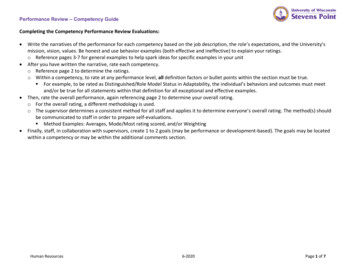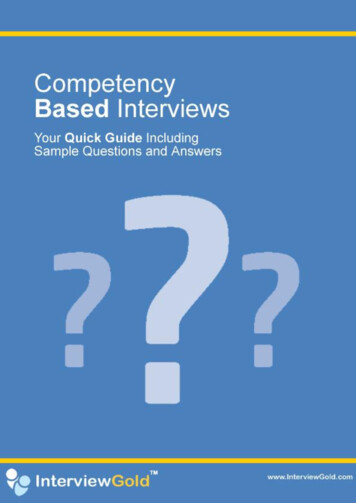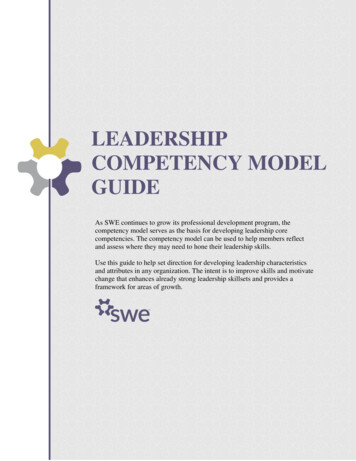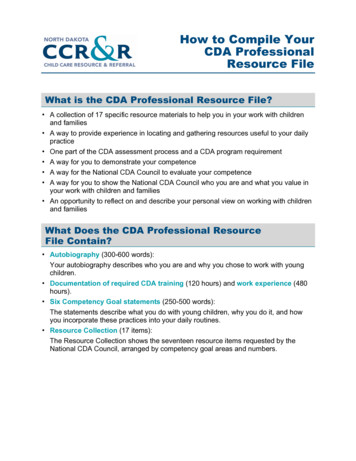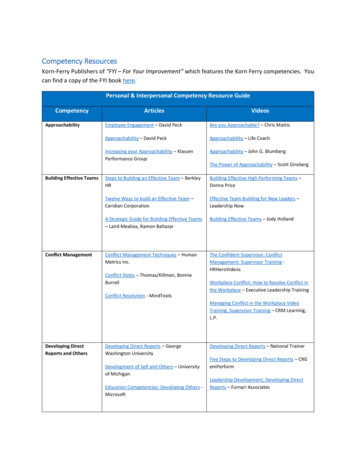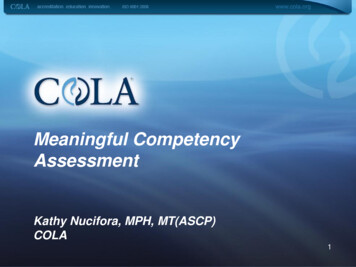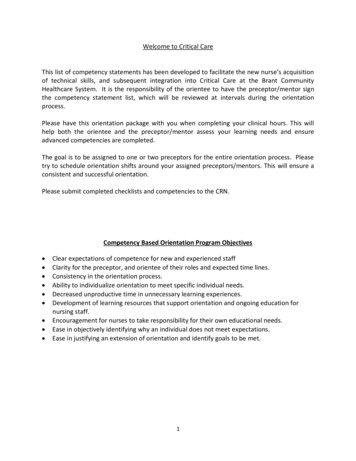
Transcription
Welcome to Critical CareThis list of competency statements has been developed to facilitate the new nurse’s acquisitionof technical skills, and subsequent integration into Critical Care at the Brant CommunityHealthcare System. It is the responsibility of the orientee to have the preceptor/mentor signthe competency statement list, which will be reviewed at intervals during the orientationprocess.Please have this orientation package with you when completing your clinical hours. This willhelp both the orientee and the preceptor/mentor assess your learning needs and ensureadvanced competencies are completed.The goal is to be assigned to one or two preceptors for the entire orientation process. Pleasetry to schedule orientation shifts around your assigned preceptors/mentors. This will ensure aconsistent and successful orientation.Please submit completed checklists and competencies to the CRN.Competency Based Orientation Program Objectives Clear expectations of competence for new and experienced staffClarity for the preceptor, and orientee of their roles and expected time lines.Consistency in the orientation process.Ability to individualize orientation to meet specific individual needs.Decreased unproductive time in unnecessary learning experiences.Development of learning resources that support orientation and ongoing education fornursing staff.Encouragement for nurses to take responsibility for their own educational needs.Ease in objectively identifying why an individual does not meet expectations.Ease in justifying an extension of orientation and identify goals to be met.1
THE ORIENTATION PROCESSAfter the new nurse is hired, she/he meets with the clinician to receive the orientation folderand schedule Clinical Resource Nurse explains the orientation program and answers questionsThe new staff member, preceptor and Clinical Resource Nurse will establish a plan fororientation based on the identified learning needs.The length of orientation is based on: Previous experience length of time to complete identified learning needsMID-ORIENTATION EVALUATIONThe Clinical Resource Nurse meets with the new staff member and preceptor to: Review the learning needs assessment and identify barriers to meeting the learning needs Assist new staff member and preceptor to develop strategies to meet learning needsEND OF ORIENTATIONThe Clinical Resource Nurse meets with the new staff member to: Review the learning needs assessment for incomplete items and establish a learning planfor meeting learning needs. Evaluate the need for further orientation Offer further resources based on continuing learning needs2
Skills and Advanced Competencies Checklist for New StaffName: Dates of Orientation:Precepted By: # Hours:Please ensure checklist is handed in to Clinical Resource Nurse once completed, to be placed inindividual education record file.Self-Directed Learning PackageDate PackageReceivedTest CompletedDate / InitialSkill ChecklistCompletedDate / InitialBasic Cardiac ArrhythmiasVenipunctureIVCentral Venous Access DevicesCVP MonitoringArterial LinesEpidural12 and 15 lead ECGBIPAP/CPAPMechanical VentilationNeuromuscular Blocking AgentsPacemakersLifesaving drugsDefibrillationAll nurses at BCHS are also responsible for maintaining their BCLS Glucometer certification(done annually), and all hospital medworxx requirements.3
Orientation to Critical CareName: Date Orientation begins: (150 hrs)BLS Expiry date: ACLS expiry date:Critical Care Certificate:Depending on level of the orientee, the timelines may be negotiated as necessary. Please fill inanticipated date of completion in the first column. Orientee and Mentor to initial each step inthe third column as completed. The CCU Orientation Manual can be accessed as PDF files on theN drive (VS Clinical) under Critical Care Orientation Package Critical Care OrientationPackage 1- 3.TimelineOrientation goal to be metDate completed,initialsInitial day in CCUMeet with CRN to discuss orientation plan,Date:Date:timeline, and assess learning needsPre-assigned Mentors by CRN: Try to align/clinical hours in advancedAfter 2 weeksDate:Venipuncture certification completeIV start certification completeTrillium Gift of Life education provided byCRNAfter 1 monthDate:Competency Statement #1:Describe the organization of the CCUcompleteCompetency Statement #2:Demonstrate Effective Communication SkillsAppropriate to the Critical Care EnvironmentcompleteAfter 3 months/150 hoursDate:Self-directed learning package Basic CardiacArrhythmias irected learning package Central Venous Date:Access Devices/4
Self-directed learning package for ArterialLines completeSelf-directed learning package for CVPMonitoring and CVAD completeSelf-directed learning package forNeuromuscular Blocking Agents completeSelf-directed learning package for EpiduralscompleteCompetency Statement #3:Provides comprehensive care in the followingareas completeAfter 6 monthsDate:After 12 monthsDate:Date:/Date:/Date:/Date:/Date:/3 month performance evaluation completeDate:/Mechanical ventilation certification for bothinvasive and non-invasive ventilationcomplete (includes self-directed learningpackage, formal session with RRT and handson learning)Date:/6 month performance evaluation completeDate:/Date:/Initial delegation with physician forpacemakers, defibrillation and lifesavingdrugs complete5
Critical Care Unit CompetenciesIt is the responsibility of the individual nurse to inform the Central Resource Nurse that he or sheis not competent to perform the skill in question and to participate in educational arrangementsmade to help maintain or gain competency in the skill.Competency Statement #1: Describe the organization of the CCU1. Locate emergency equipment:Orientee/Preceptor Initials:Additional- Defibrillator/Requirements:- Airway, central line, specialprocedure carts- Fire extinguishers and alarms- Oxygen and air shut off valves2. Locate:Orientee/Preceptor Initials:- Sign-in sheets and staffing rotors/- Huddle board, Rapid Rounds board- Staff assignment record and board- Unit manuals- Medication room- Clean and dirty utility rooms- Visitor waiting room, quiet room- CRN office3. Locate equipment in patient room: Orientee/Preceptor Initials:- Suction/- Oxygen- Call bell- Code Blue button4. Demonstrate use of the computerto obtain lab results, results ofdiagnostic tests, prior patient visits,etc.Orientee/Preceptor Initials:/5.-Orientee/Preceptor Initials:/-Operate CCU equipment:Critical Care bed and lift equipmentGlucometerBedside monitor, transportmonitorsSigma IV pump,Central monitoring systemPCA/epidural pumpHypo/hyperthermia blanketPneumatic tube system6
6.-Describe the roles of:Orientee/Preceptor Initials:Group Lead and CRN/Unit ClerkMost Responsible Physician (MRP)After hours on call physiciansHealthcare team: RRT, dietician,social work, physio, Navigator,CCAC, pharmacy, etc.Competency Statement #2: Demonstrate effective communication skills appropriate to theCCU environment1. Clearly and concisely report toOrientee/Preceptor Initials:oncoming shift, during bedside/rounds and at Rapid Rounds.2.3.-Accurately document using:PCS, eMAROrder transcription and entryDowntime paper chartingTransfer sheetsDescribe communication via:Huddle boardEmail and staff mailboxesStaff meetings, bulletin boardsOrientee/Preceptor Initials:/Orientee/Preceptor Initials:/4. Recognize and develop strategiesOrientee/Preceptor Initials:Additionalto resolve interpersonal conflicts/Requirements:with External (i.e. patient) andInternal (i.e. staff members)sourcesCompetency Statement #3: Provides comprehensive care in the following areas:Neurology1. Interprets and evaluates dataOrientee/Preceptor Initials:including:/- Physical assessment- Glasgow coma, Canadianneurological scales- CAM-ICU- Lab and diagnostic results2. Recognizes actual or potential life- Orientee/Preceptor Initials:threatening alterations in function/(ineffective thermoregulation,motor and/or sensory impairments,cerebral tissue perfusion7
impairments - stroke, meningitis,seizures)3. Identifies and/or demonstratesappropriate nursing interventionsto correct alterations in cerebraltissue perfusion (anticonvulsants,diuretics, sedatives, neuromuscularblocking agents, TPA)4. Identifies and/or demonstratesknowledge of stroke protocol carepath and preprinted order sets.Cardiovascular1. Interprets and evaluates dataincluding:- Physical assessment (BP, pulses,skin temp, heart sounds, JVP)- Lab results (CK, troponin, CBC,coagulation, electrolytes, druglevels) and cardiac tests (echo,stress test, MIBI, angios)- Technological supports(cardiacmonitors, 12/15 lead ECG,pacemakers, arterial/CVP lines)2. Recognizes actual or potential lifethreatening situations(cardiogenic/hypovolemic shock,ACS, cardiac tamponade,pulmonary edema, hypertension,thoracic/abdominal aneurysm,thrombosis, embolus, valvulardisease)3. Identifies and/or demonstratesappropriate intervention(s) tocorrect alterations in perfusion,output (inotropes, vasopressors,vasodilators, thrombolytics,antiplatelets, anticoagulents, fluid,electrolytes, blood, blood products,antiarrhythmics, antihypertensives,temporary transvenous or externalpacing)Orientee/Preceptor Initials:/Orientee/Preceptor Initials:/Orientee/Preceptor Initials:/Orientee/Preceptor Initials:/Orientee/Preceptor Initials:/8AdditionalRequirements:
4. Demonstrates knowledge of:- Cardiac arrest and arrhythmiaprotocols- Defibrillation and cardioversionprotocols- Code Blue resuscitation5. Assisting with and/or performing:- Arterial line maintenance andremoval- Elective cardioversionsRespiratory1. Interprets and evaluates dataincluding:- Physical assessment, pulseoximetry- Lab results (inc. arterial bloodgases) and diagnostic tests (CXR,peak flows, PFT’s)- Mechanical ventilator weaningparameters- Ventilation info (parameters,modes, pressures)2. Recognizes actual or potential lifethreatening alterations (ineffectiveairway, asthma, COPD,pneumo/hemothorax, impaired gasexchange, ARDS, pulmonaryembolism, pneumonia)3. Identifies and/or assists with orperforms appropriate interventionsto correct alterations in function(bag/valve mask, oral or nasalairway, positioning, suctioning,chest tubes, ETT, trach tubes)Orientee/Preceptor Initials:/4. Administering and/or monitoringpharmacological agents (O2administration, analgesics,sedatives, bronchodilators,steroids, neuromuscular blockingagents)Orientee/Preceptor r Initials:/Orientee/Preceptor Initials:/Orientee/Preceptor Initials:/Orientee/Preceptor Initials:/9AdditionalRequirements:
5. Care of the intubated mechanicallyventilated patient (indications,airway management, ETT, trachs,oxygenation, PEEP, FiO2, modes,rates, volumes, troubleshooting,ventilation/ weaning promotion,nutrition, pain, sedation, rest)6. Care of patients with non-invasiveventilation techniques (BiPAP,CPAP)Gastrointestinal1. Interprets and evaluates dataincluding:- Physical assessment- Lab and diagnostic results(amylase, lipase, liver profile,ultrasound, CT)2. Recognize actual or potential lifethreatening alterations(ischemic/infarcted bowel, hepaticfailure, peritonitis, pancreatitis, GIbleed, complex surgicalinterventions3. Identifies and/or demonstratesappropriate interventions tocorrect alterations ingastrointestinal function (TPN,enteral feeding, abdominaldrainage, complex wounds)4. Administer and monitorpharmacological agents (motilityagents, proton pump inhibitors,antiemetics, GI vasoconstrictors)Genitourinary/Renal1. Monitors and evaluates dataincluding:- Physical assessment (edema, urineoutput)- History- Lab and diagnostic results(electrolytes, eGFR, fluid balance,weight, drug levels)Orientee/Preceptor Initials:/Orientee/Preceptor Initials:/Orientee/Preceptor Initials:/Orientee/Preceptor Initials:/Orientee/Preceptor Initials:/Orientee/Preceptor Initials:/Orientee/Preceptor Initials:/10AdditionalRequirements:
2. Recognizes actual or potential lifethreatening alterations including:- Nephrotoxic agents (contrastagents, drugs, poisons, diuretics,vasopressors, antibodies)- Electrolyte and acid/baseimbalanceOrientee/Preceptor Initials:/3. Administer and monitorpharmacological agents (diuretics,vasodilators, nephroprotectiveagents, treating hyperkalemia)Orientee/Preceptor Initials:/Endocrine1. Interprets and evaluates dataincluding:- Lab and diagnostic results (bloodsugar, osmolality, TSH, electrolytes)2. Recognizes actual or potential lifethreatening alterations (ADH,SIADH, DKA, HHNK, adrenalinsufficiency, hyper orhypothyroidism)Protocols reviewed3. Identifies and/or demonstratesappropriate interventions tocorrect alterations in endocrinefunction (insulin infusion, hormonereplacement, electrolyte balance,fluid management)Reproductive1. Monitors and evaluates dataincluding:- History- Lab and diagnostic results- Sexual assault/domesticviolence protocol2. Recognizes actual or potential lifethreatening (infection, complexsurgery)Musculoskeletal and Integumentary1. Monitors and evaluates dataincluding:Orientee/Preceptor Initials:/Orientee/Preceptor Initials:/Orientee/Preceptor Initials:/Orientee/Preceptor Initials:/Orientee/Preceptor Initials:/Orientee/Preceptor Initials:/11
--Physical assessment (skin integrity,ROM, circulation, temperature,sensation)Lab results (cultures, CK,myoglobin)Diagnostic tests (XR, CT, MRI)Braden scale, wound assessment2. Recognizes potential or actual lifethreatening alterations (malignanthyperthermia, compartmentsyndrome, complex wounds,rhabdomyelosis, fractures,amputations, infection)3. Identifies and/or demonstratesappropriate interventions relatedto alterations in function (splints,immobilizers, traction, preventionof complications r/t immobility,complex woundst, use oftherapeutic surfaces)Immunological and Hematological1. Monitors and evaluates dataincluding:- Physical assessment (invasivesites or devices)- Lab results2. Recognizes actual or potential lifethreatening alterations (Sepsis, DIC,DVT)3. Identifies and/or demonstratesappropriate interventions tocorrect alterations (aseptictechnique, protective isolation,nutritional support, administrationof blood products and/orpharmacological agents)Psychosocial1. Monitors and evaluates dataincluding:Orientee/Preceptor Initials:/Orientee/Preceptor Initials:/Orientee/Preceptor Initials:/Orientee/Preceptor Initials:/Orientee/Preceptor Initials:/Orientee/Preceptor Initials:/12AdditionalRequirements:
-Coping skillsPain and anxietyCurrent and past experiences inthe healthcare system2. Selects appropriate interventions(involving patient and family,facilitating communication,facilitating and supporting end oflife choices and advanceddirectives)3. Selecting appropriate interventionsto prevent or minimize delirium(CAM-ICU tool, managingenvironment, identifying triggers,promoting sleep, managing pain)AdditionalRequirements:Orientee/Preceptor Initials:/Orientee/Preceptor Initials:/13
The Brant Community Health Care SystemRN Skill Competency Checklist for VenipunctureAttempt #1Attempt #21. Verifies orders & checks labels, gathersequipment, washes hands2. Greets patient, introduces self, verifies correctpatient by checking armband.3. Explains procedure and obtains verbal consent4. Instructs or assists patient with proper positioning5. Applies gloves and other PPE as required6. Positions patients arm comfortably7. Prepares equipment8. Apply tourniquet 2-4 inches above the site (bicep)and instruct patient to make a fist9. Assess for vein sites by palpation and/or runningfingers up forearm10. Cleanses site with 70% isopropyl alcohol in acircular motion-central to periphery11. Allow alcohol to air dry12. Inspects needle for burrs, hooks or other defects13. Anchor vein and inserts needle bevel up14. Remove tourniquet when blood flow isestablished/instructs patient to relax fist15. Collects blood specimens correct order of thedraw with minimal/optimal volumes16. After last tube collected, removes tube fromholder & removes needle from patient.17. Applies pressure to puncture site with cotton ball(2-3 min. or until blood stops flowing)18. Labels specimen with date, time, first initial, lastname and title.19. Checks site for bleeding, instructs patient to applypressure to site if needed.20. Disposes of equipment appropriately and DOESNOT RECAP NEEDLES.21. Sends blood to lab using biohazard precautions.22. Removes gloves & washes hands23. Documents according to policyPreceptor’s Initials:Date:14Attempt #3
IV InsertionCompetency is complete after the orientee has successfully initiated five (5) IV starts undersupervision according to the following steps.IV#1IV #2 IV #3 IV #4 IV#51. Verify doctor’s order2. Check patient allergies3. Verify patient’s identity using 2unique patient identifiers4. Performs Hand Hygiene andapplies appropriate PPE.5. Introduce self, designation andskill/task to be performed andobtain verbal consent.6. Assesses potential IV sites7. Chooses appropriate site applytourniquet, select site andremove tourniquet8. Select appropriate gauge size9. Applies clean gloves10. Apply tourniquet11. Cleanse site with 5%chlorhexidine gluconate and 70%alcohol swab. Allow to dry12. Stabilize vein, insert and advancecatheter13. Releases tourniquet14. Applies dressing15. Connects IV tubing or primedsaline lock16. Securely tapes device andindicates date, time, initials andgauge.17. Remove PPE18. Performs Hand Hygiene19. DocumentSupervisor’s InitialsDate of Insertion15Comments
12 and 15 Lead ECG Performance ChecklistCriteriaPreceptor Initials when CriteriaMet12 Lead:Obtain an order, gather equipment, enter data in ECGmachineWash handsVerify patient identification, identify self and purpose ofECGCorrectly place ECG leads on limbs and torsoObtain 12-lead ECGPrint, transmit and save ECGRemove leads if indicatedPlace copy of ECG on patient chart, document according topolicy15 Lead:As above, but including leads V4R, V8, V9Obtain 15-lead ECGPrint, transmit and save ECGComments:16
Written Test for Epidural Pain Management, Including Intermittent Epidural NarcoticInjectionDate: Name:1. The spinal cord extends to the level of the:a) Sacrumb) Upper lumbar vertebraec) Mid-thoraxd) 5th lumbar vertebraee) Coccyx2. Match the layer of the spinal cord with its correct definition:Dura matera) Tough, fibrous outermost membrane which covers the brain,spinal cord and nerve roots like a protective sacArachnoidb) Lies outside the dura mater, and contains blood vessels and fatmembranetissueEpidural spacec) The thin middle membrane that is located beneath the duramater, enclosing the arachnoid spaceSubarachnoidd) Lies between the arachnoid membrane and pia mater; is filledspacewith cerebral spinal fluide) Lies between the arachnoid membrane and dura mater; is filledwith cerebral spinal fluid3. What is the correct placement of an epidural catheter?a) Between the spinal cord and dura materb) Between the dura mater and the boney vertebral archc) In the subarachnoid space in the spinal cordd) In the ventral nerve root of the spinal cord4. TRUE or FALSE: The spaces between L2-L3 and L3-L4 are most commonly used for epiduralcatheter placement.5. Which of the following is contained within the epidural space? (Circle all that apply)a) Fatty tissued) Lymphaticsb) Nervese) Blood vesselsc) Cerebral spinal fluid6. Identify the correct statements regarding epidural narcotics:a) They provide regional pain control by inhibiting the release of Substance P, therebyblocking the transmission of pain impulses to the cerebral cortex.b) The prevent uptake of acetylecholine by the postsynaptic neuronc) They act directly on the parasympathetic systemd) They provide analgesia with no motor blocke) They may cause respiratory depression17
7. TRUE or FALSE: Epidural narcotics bind to opiate receptors in the substantia gelitanosawithin the dorsal horn of the spinal cord.8. Epidural narcotics offer advantages over the parenteral route. (Circle all that apply)a) No risk of respiratory depressionb) Less potential for CNS affects – BP changes, sedation, disorientation, muscle weaknessc) A reduced frequency in dosingd) Pain relief is better and lasts longere) Improved ventilation and earlier mobilizationf) Reduced incidence of urinary retention9. Which statement regarding epidural analgesia is true?a) Narcotics given through an epidural catheter diffuse slowly from the epidural space,through the dural membrane and into the CSF in the subarachnoid space.b) Narcotics given through an epidural catheter are injected directly into the CSF in thesubarachnoid space.c) Narcotics given through an epidural can only be administered as intermittent bolusinjections.d) Sensory and motor assessments must be done for patients receiving epidural analgesia.10. In which of the following conditions is epidural analgesia contraindicated for pain relief?(Circle all that apply)a) A patient with a pelvic sepsisb) A motor vehicle accident patient who has a suspected spinal injuryc) A patient who has undergone a right hemicolectomyd) A patient who has intractable pain related to a metastatic bowel cancere) A patient who is taking Coumadin for his “heart condition”f) An elderly patient who has had an ORIF of a left hip fracture11. Patients receiving epidural narcotics for analgesia should be:a) Permitted to mobilize about the unit as tolerated and encouraged to do their post-oprespiratory exercisesb) Confined to their beds, catheterized Q2H and sedated with Ativan PRNc) Made to walk from the elevator to their beds on return from PACUd) Left alone except for routine post-op vital monitoring12. TRUE or FALSE: Sensory, motor and sympathetic involvement is associated with epiduralnarcotics.13. TRUE or FALSE: Early respiratory depression can occur as early as 1 hour post-injection andmay be secondary to the rapid systemic absorption of a narcotic from the epidural space.14. TRUE or FALSE: Morphine is a highly lipophilic drug with a rapid onset and short duration ofaction.18
15. Symptoms of late respiratory depression are:a) Changes in level of consciousness, convulsions, tachycardiab) Changes in level of consciousness, markedly reduced rate and depth of respirations, O2sat 90%c) Increased temperature, decreased BP and respiratory rate 12/min16. Side effects of epidural narcotics most commonly include: (Circle all that apply)a) Pruritisd) Nausea and vomitingb) Tinnitus and metallic taste in mouthe) Sensory and motor blockc) Respiratory depressionf) Hypotension17. TRUE or FALSE: Respiratory depression can occur as early as 1 hour and as late as 24 hoursafter an epidural narcotic bolus injection.18. TRUE or FALSE: Intravenous naloxone should be given if the respiratory rate is 8 breathsper minute.19. Patient health teaching related to epidural analgesia will include: (Circle all that apply)a) Explaining the monitoring routine used.b) What the possible side effects are.c) The importance of notifying a nurse if any side effects occur.d) The importance of letting the nurse know about any increased pain.e) Both the patient and their family.20. Mrs S. is a 42 year old female patient who underwent a total abdominal hysterectomy andwho just arrived to your unit from PACU. She received Epimorph intra-op.a) What is the monitoring protocol for the first 24 hours?b) You have noticed from the intake and output record that Mrs S. has not yet voided.What are the actions that you will take to address this problem?c) Three hours after Mrs S. received her Epimorph, she is complaining of “itching” aroundher mouth, nose and neck. What actions will you take to address this problem?d) What is the most serious side effect of epidural narcotics after the first 1 to 2 hourspost-injection?e) What assessment parameters will you use to monitor for this potential problem?19
21. When caring for a patient who has received epidural narcotics, the following are all nursingresponsibilities except:a) Monitoring the patients O2 saturation levelsb) Ensuring that naloxone is readily availablec) Notifying the surgeon if comfort level is not adequately controlledd) Administering IV narcotics, as ordered if the patient complains of paine) Documenting the patient’s response to epidural analgesia22. TRUE or FALSE: 24 hours have passed since your patient has received epidural narcotics,and he is now complaining of nausea. You administer an antiemetic as ordered on theEpidural/Spinal protocol.23. You noted blood returning during your pre-injection withdrawal through the epiduralcatheter. What does this indicate?24. You note clear, colourless liquid returning during your pre-injection withdrawal through theepidural catheter. What does this indicate?25. For the above two situations, you will:a) Continue with your injection.b) Stop what you are doing, replace the cap on the catheter and call the anesthesiologist.c) Inject half the dose and withdraw again to see what return you will get.d) Pull the catheter out and call the anesthesiologist.26. TRUE or FALSE: A doctor’s order is required for the removal of an epidural catheter.27. What position will you place your patient in when removing the epidural catheter?a) Lying supine with head off pillow.b) Left lateral side-lying position in Trendelenburgc) In the fetal position with legs drawn up to the chest28. If significant resistance is felt on the catheter after your second attempt at removal, youshould:20
Epidural Top-Up ChecklistName:ProcedureYes1.2.3.4.Check physician’s orderEnsure patent IV sitePerform hand hygienePrepare epidural injection using aseptic technique and double checkwith a 2nd RN5. Explain the procedure to the patient6. Monitor and record baseline vitals (BP, HR, RR, SaO2, sedation level,pain score)7. Assess epidural catheter insertion site, check for presence of filter,adapter and epidural label8. Check epidural catheter marking level to ensure that the catheter hasnot migrated9. Remove cap from epidural catheter, connect syringe via filter and gentlyaspirate- If blood or excess fluid comes back easily when pulling back on thesyringe, DO NOT INJECT- If no blood or excess fluid comes back, inject medication at a rate of 1 ml/sec10. Remove syringe and replace cap11. Document in eMAR and in PCS appropriatelyPreceptor’s signature: Date:21No
Epidural Continuous Infusion Skill ChecklistName:ProcedureYes1.2.3.4.Checks physician’s orderEnsure patent IV sitePerform hand hygienePrepare epidural infusion bag using aseptic technique and double checkwith a 2nd RN5. Prime epidural tubing with no injection ports6. Program epidural infusion pump according to physician’s orders anddouble check with 2nd RN7. Explain procedure to patient8. Monitor and record baseline vitals (BP, HR, RR, SaO2, sedation level,pain score)9. Assess epidural catheter insertion site, check for presence of filter,adapter and epidural label10. Check epidural catheter marking level to ensure that the catheter hasnot migrated11. Remove cap from epidural catheter, connect syringe via filter and gentlyaspirate- If blood or excess fluid comes back easily when pulling back on thesyringe, DO NOT INJECT- If no blood or excess fluid comes back, connect epidural tubing toleur lock connector on filter of epidural catheter12. Initiate infusion according to orders13. Document on MAR and in PCS appropriatelyPreceptor’s signature: Date:22No
Epidural Catheter Removal ChecklistName:Procedure1. Checks physician’s order for epidural catheter removal2. Check MAR. If on anticoagulant therapy, follow guidelines for epiduralcatheter removal according to anticoagulant3. Explain procedure to patient4. Perform hand hygiene5. Position patient on side with knees drawn tightly to chest6. Remove transparent dressing7. Gently and evenly pull catheter until it is removed. If resistance is felt,reposition patient and try again. If resistance is still felt, leavecatheter in situ and contact anesthesiologist8. Check markings on catheter to ensure the catheter has been removedintact9. Apply small dressing to insertion site10. Send catheter tip for culture and sensitivity if clinically warranted andordered11. Document appropriatelyPreceptor’s signature: Date:23YesNo
Non Invasive Positive Pressure Ventilation (NPPV) Quiz1. TRUE or FALSE: NPPV provides the patient with respiratory assistance through positivepressure airway pressure support.2. List the four diseases known to respond to NPPV:3. List eight contraindications to NPPV:4. Why would you want to use NPPV over invasive ventilation?5. When you are first starting someone on NPPV in the acute situation, what settings aregenerally used?IPAPEPAP6. IPAP means:a) Initial positive airway pressureb) Inspiratory positive airway pressurec) Intended positive airway pressure7. EPAP means:a) Expiratory positive airway pressureb) End tidal positive airway pressurec) Expiratory phase airway pressure8. Which statement(s) about CPAP is true?a) It applies negative pressure throughout the respiratory cycleb) It doesn’t allow spontaneous breathsc) It helps keep the alveoli open during the end expiratory phased) It increases resistance for spontaneous breathing9. NPPV results in:a) Reduced CO2 levels as alveolar ventilation is improvedb) Increased O2 levels due to increased functional residual capacityc) Increased CO2 levels as alveolar ventilation is improvedd) Reduced O2 levels due to increased functional residual capacity10. One of the risk factors for patients on NPPV is the development of skin irritation orbreakdown. List interventions you could initiated to prevent this:24
Arterial Pressure Line Theory Quiz1. State three indications for the use of arterial lines.2. Draw an arterial pressure waveform and label the following: systolic peak, diastole, diacriticnotch3. What test must be done prior to the insertion
Welcome to Critical Care This list of competency statements has been developed to facilitate the new nurse’s acquisition of technical skills, and subsequent integration into Critical Care at the Brant Community Healthcare System. It is the respons

